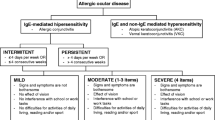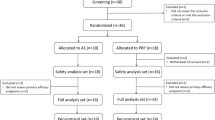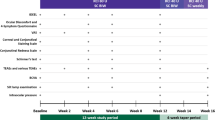Abstract
This randomized, double-masked, active-control, parallel-group trial compared the mast cell stabilizers pemirolast potassium 0.1% and nedocromil sodium 2% in the treatment of seasonal allergic conjunctivitis. Pemirolast is currently indicated for four-times-daily administration, nedocromil, for twice-daily dosing. Both ophthalmic solutions were instilled bilaterally twice a day for 8 weeks. The study involved four office visits and two telephone contacts. Participants evaluated their symptoms daily in take-home diaries (itching was the primary efficacy variable) and completed questionnaires to assess comfort. Of a total enrollment of 80, 78 patients completed the study. No significant differences were found between pemirolast and nedocromil on any signs or symptoms of allergic conjunctivitis (redness, chemosis, itching, eyelid swelling). At each visit, pemirolast was rated significantly more comfortable than nedocromil. A significantly higher percentage of the pemirolast group experienced no signs or symptoms at work or school (58% vs 28%; P = .005). The number of adverse events did not differ significantly between groups. Twice-daily administration of pemirolast potassium was as efficacious and safe as twice-daily nedocromil sodium in the 8-week treatment of ragweed allergic conjunctivitis and was superior to nedocromil in comfort. Increased comfort with pemirolast may increase patient satisfaction and compliance with therapy.
Similar content being viewed by others
References
Abelson MB, Chapin MJ. Current and future topical treatments for ocular allergy.Compr Ophthalmol. 2000;1:303–320.
Allansmith MR, Ross RN. Ocular allergy.Clin Allergy. 1988;18:1–13.
Kinet JP. The high-affinity receptor for immunoglobulin-E: structure, function, and role in allergy. In: Gallin JI, Goldstein IM, Snyderman R, eds.Inflammation: Basic Principles and Clinical Correlates. 2nd ed. New York: Raven Press; 1992:702–705.
Allansmith MR. Immunology of the eye. In: Allansmith MR, ed.The Eye and Immunology. St. Louis, Mo: CV Mosby; 1982:99–115.
Juniper EF, Guyatt GH. Development and testing of a new measure of health status for clinical trials in rhinoconjunctivitis.Clin Exp Allergy. 1991;21:77–83.
Juniper EF. Rhinitis management: the subject’s perspective.Clin Exp Allergy. 1998;28(suppl 6): 34–38.
Berdy GJ, Abelson MB. Antihistamines and mast cell stabilizers in allergic ocular disease. In: Albert DM, Jakobiec FA, eds.Principles and Practice of Ophthalmology. Philadelphia: WB Saunders; 1994:1028–1042.
Norris AA, Holgate ST. Cromolyn sodium and nedocromil sodium. In: Middleton E, Reed CE, Ellis EF, Adkinson NF Jr, Yunginger JW, Busse WW, eds.Allergy. Principles and Practice. Boston: CV Mosby; 1998:661–667.
Kjellman MN-I, Stevens MT. Clinical experience with Tilavist: an overview of efficacy and safety.Allergy. 1995;50(suppl 21):14–22.
El Hennawi M. A double-blind placebo controlled group comparative study of ophthalmic sodium cromoglycate and nedocromil sodium in the treatment of vernal keratoconjunctivitis.Br J Ophthalmol. 1994;78:365–369.
Alexander M. Comparative therapeutic studies with Tilavist.Allergy. 1995;50(suppl 21):23–29.
Van Bijsterveld OP, Moons L, Verdonck M, et al. Nedocromil sodium treats symptoms of perennial allergic conjunctivitis not fully controlled by sodium cromoglycate. A double-masked placebo controlled group comparative study.Ocular Immunol Inflamm. 1994;2:177–186.
Fujimiya H, Nakashimia S, Miyata H, Nozawa Y. Effect of a novel antiallergic drug, pemirolast, on activation of rat peritoneal mast cells: inhibition of exocytotic responses and membrane phospholipid turnover.Int Arch Allergy Appl Immunol. 1991;96:62–67.
Abelson MB. Comparison of the conjunctival allergen challenge with the environmental model of allergic conjunctivitis.Acta Ophthalmol Scand. 1999;77(suppl 228):38–42.
Abelson MB, Chambers WA, Smith LM. Conjunctival allergen challenge. A clinical approach to studying allergic conjunctivitis.Arch Ophthalmol. 1990;108:84–88.
Nelson P, Aspinall P, Papasouliotis O, Worton B, O’Brien C. Quality of life in glaucoma and its relationship with visual function.J Glaucoma. 2003;12:139–150.
Author information
Authors and Affiliations
Rights and permissions
About this article
Cite this article
Shulman, D.G. Two mast cell stabilizers, pemirolast potassium 0.1% and nedocromil sodium 2%, in the treatment of seasonal allergic conjunctivitis: A comparative study. Adv Therapy 20, 31–40 (2003). https://doi.org/10.1007/BF02850117
Issue Date:
DOI: https://doi.org/10.1007/BF02850117




